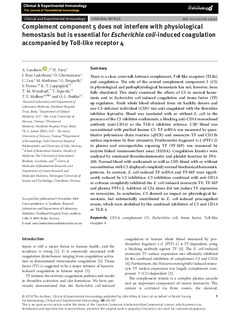| dc.contributor.author | Landsem, Anne | |
| dc.contributor.author | Fure, Hilde | |
| dc.contributor.author | Ludviksen, Judith K | |
| dc.contributor.author | Christiansen, Dorte | |
| dc.contributor.author | Lau, Corinna | |
| dc.contributor.author | Mathisen, Monica Dammen | |
| dc.contributor.author | Bergseth, Grete | |
| dc.contributor.author | Nymo, Stig Haugset | |
| dc.contributor.author | Lappegård, Knut Tore | |
| dc.contributor.author | Woodruff, T. M. | |
| dc.contributor.author | Espevik, Terje | |
| dc.contributor.author | Mollnes, Tom Eirik | |
| dc.contributor.author | Brekke, Ole-Lars | |
| dc.date.accessioned | 2019-02-28T11:54:23Z | |
| dc.date.available | 2019-02-28T11:54:23Z | |
| dc.date.created | 2019-02-07T10:34:22Z | |
| dc.date.issued | 2018 | |
| dc.identifier.issn | 0009-9104 | |
| dc.identifier.uri | http://hdl.handle.net/11250/2588030 | |
| dc.description.abstract | There is a close cross‐talk between complement, Toll‐like receptors (TLRs) and coagulation. The role of the central complement component 5 (C5) in physiological and pathophysiological hemostasis has not, however, been fully elucidated. This study examined the effects of C5 in normal hemostasis and in Escherichia coli‐induced coagulation and tissue factor (TF) up‐regulation. Fresh whole blood obtained from six healthy donors and one C5‐deficient individual (C5D) was anti‐coagulated with the thrombin inhibitor lepirudin. Blood was incubated with or without E. coli in the presence of the C5 inhibitor eculizumab, a blocking anti‐CD14 monoclonal antibody (anti‐CD14) or the TLR‐4 inhibitor eritoran. C5D blood was reconstituted with purified human C5. TF mRNA was measured by quantitative polymerase chain reaction (qPCR) and monocyte TF and CD11b surface expression by flow cytometry. Prothrombin fragment 1+2 (PTF1·2) in plasma and microparticles exposing TF (TF‐MP) was measured by enzyme‐linked immunosorbent assay (ELISA). Coagulation kinetics were analyzed by rotational thromboelastometry and platelet function by PFA‐200. Normal blood with eculizumab as well as C5D blood with or without reconstitution with C5 displayed completely normal biochemical hemostatic patterns. In contrast, E. coli‐induced TF mRNA and TF‐MP were significantly reduced by C5 inhibition. C5 inhibition combined with anti‐CD14 or eritoran completely inhibited the E. coli‐induced monocyte TF, TF‐MP and plasma PTF1·2. Addition of C5a alone did not induce TF expression on monocytes. In conclusion, C5 showed no impact on physiological hemostasis, but substantially contributed to E. coli‐induced procoagulant events, which were abolished by the combined inhibition of C5 and CD14 or TLR‐4. | nb_NO |
| dc.language.iso | eng | nb_NO |
| dc.publisher | Wiley | nb_NO |
| dc.rights | Navngivelse-Ikkekommersiell 4.0 Internasjonal | * |
| dc.rights.uri | http://creativecommons.org/licenses/by-nc/4.0/deed.no | * |
| dc.title | Complement component 5 does not interfere with physiological hemostasis but is essential for Escherichia coli-induced coagulation accompanied by Toll-like receptor 4. | nb_NO |
| dc.type | Journal article | nb_NO |
| dc.type | Peer reviewed | nb_NO |
| dc.description.version | publishedVersion | nb_NO |
| dc.source.journal | Clinical and Experimental Immunology | nb_NO |
| dc.identifier.doi | 10.1111/cei.13240 | |
| dc.identifier.cristin | 1674386 | |
| dc.relation.project | Norges forskningsråd: 223255 | nb_NO |
| dc.description.localcode | © 2018 The Authors. Clinical & Experimental Immunology published by John Wiley & Sons Ltd on behalf of British Society for Immunology This is an open access article under the terms of the Creative Commons Attribution‐NonCommercial License. | nb_NO |
| cristin.unitcode | 194,65,15,0 | |
| cristin.unitname | Institutt for klinisk og molekylær medisin | |
| cristin.ispublished | true | |
| cristin.fulltext | original | |
| cristin.qualitycode | 1 | |

